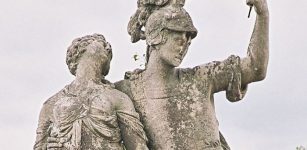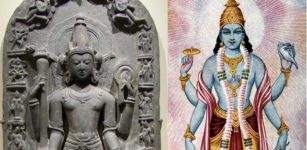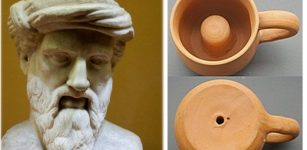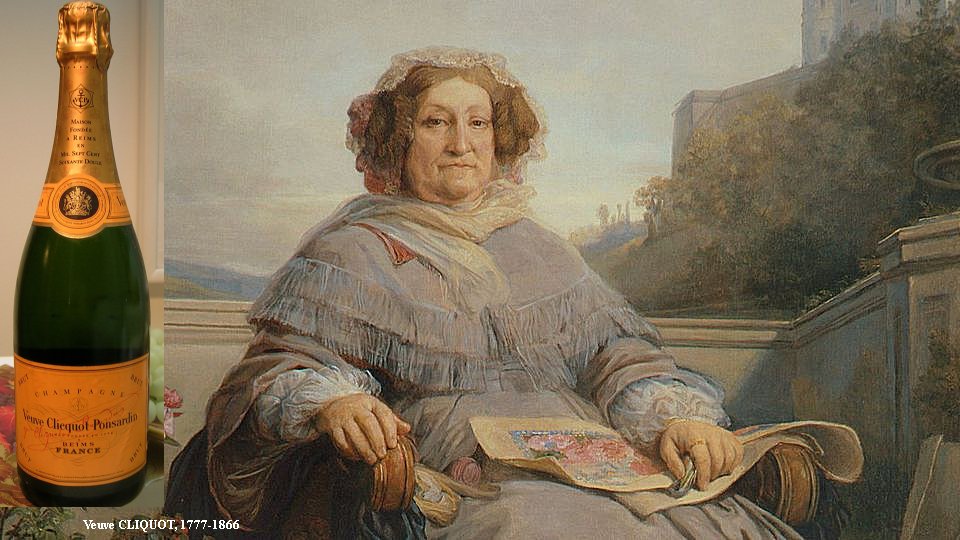Great Lady Of Champagne – Barbe-Nicole Clicquot Ponsardin: Widow, Mother, Skilled Businesswoman
A. Sutherland - AncientPages.com - Legend has it that champagne was invented by Dom Perignon, a monk from the Benedictine order, who in 1668 was lucky to taste this drink and he was so happy of his experience that he began to cry.
The most famous champagne brand was named in the monk’s honor - Dom Pérignon.
However, the method of producing champagne invented by Benedictine definitely needed an improvement, and Madame Barbe-Nicole Clicquot, known today as the ‘Great Lady of Champagne’ or ‘Widow Cliquot" (‘Veuve Cliquot’) contributed with a new method that significantly improved the quality of the drink.
Tough Decision Of 27-Year-Old Woman
For more than two centuries ago, the then 27-year-old French woman, Barbe-Nicole Clicquot decided to take over the production of champagne that she started with her husband François Clicquot. It was said that the fever took her husband’s life when he passed away on October 23, 1805.
Many people had hard to understand his cause of death because he and his wife Barbe-Nicole were dealing with the production of champagne, known for its high quality. Many people then, believed that champagne was the most effective ‘medicine’ for high fever.
Another version suggested that at the time of the death, François suffered from severe depression.
Madame Clicquot Takes Over The Family Business
After the death of her husband, Madame Clicquot was left alone with a small child. In the beginning, there was no one in the Clicquot Company who expected, the young Barbe-Nicole to take over the family business established 33 years earlier, but she did it.
In the early 19th century, it was an unprecedented decision. The women had no authority and it wasn’t accustomed to trading with them. Widow Cliquot not only stood up to the challenge of maintaining her husband's project but also modernized the company.
Fascinated by the complicated production process of champagne, she introduced several improvements.
Process Of ‘Riddling Table’ Invented
Among others, "Grande Dame du Champagne" invented the process of "the riddling table". In 1816, she discovered that by storing bottles of champagne at an angle and gradually turned them upside-down, the sediment would fall to the necks, near the cork (riddling), and from there it could be removed, leaving clear champagne.
 The Riddling Table invented by Veuve Clicquot.
The Riddling Table invented by Veuve Clicquot.
This resourceful young woman used her dining room table, which she turned on its side and drilled holes through the top so that the corks in her champagne bottles lay at a declining angle towards the floor.
Known today as the ‘the riddling table’ for sedimentation, this simple device is still used in the production of champagne.
She also created the formula of pink champagne, now highly valued among experts.
On February 10, 1806, she signed the business agreement, in which she invested her entire wealth, to start a huge business development. Barbe-Nicole was a remarkably skilled businesswoman; she knew how to run her business and she succeeded. She transformed the family production of champagne into an internationally renowned company that produced 100,000 champagne bottles a year.
She also founded a house of champagne - a company dealing with successful production and sale of this drink.
Building A Champagne Empire Was A Tough Ambition
Barbe-Nicole had many impressive ideas, which efficiently contributed to the increasing popularity of her family business.
She gave up the fight for the local market; she did not care too much about the English market.
Intuition prompted her to try to develop less dense markets. So she looked far to the east and first of all to Russia.
 Champagne Veuve Clicquot, Reims. Source
Champagne Veuve Clicquot, Reims. Source
In 1814, warned of the victory of the coalition against Napoleon (Napoleonic War (1803–1815), she ordered shipping of significant transport of 10,550 bottles to St. Petersburg, Russia, by boat. Apparently, they sold out immediately and were empty during a week. The success was such that the house could not satisfy orders.
In his novel "Eugene Onegin", Aleksandr Pushkin (1799-1837), a Russian poet and novelist, rewarded champagne and called it "blessed wine of the Gods" and Russia remained the largest importer of champagne until the October Revolution (Nov. 6–7, 1917).
Interestingly, not all deliveries of Madame Cliquot’s champagne were successful. In 2010, a shipwreck was located at the bottom of the Baltic Sea, with a few dozen bottles of the delicious and famous Veuve Clicquot champagne, dated back to around 1840.
Barbe-Nicole’s champagne business experienced both ups and downs in those tumultuous times with wars and restrictions, and the difficult political situation in Europe. One year, the company’s situation was so critical that she made attempts to sell her jewelry to cover losses but no one had enough money to pay during this time. Once again, this brilliant businesswoman coped well with the problems and lifted the company.
During the 1820s, Veuve Clicquot & Cie exported approximately 175,000 bottles of champagne, and for about ten years, she expanded her empire even more.
She died in 1866 at the age of 88.
Today, Veuve Clicquot produces more than 10 million bottles of champagne, which goes to probably all the markets around the world.
Written by - A. Sutherland - AncientPages.com Senior Staff Writer
Copyright © AncientPages.com All rights reserved. This material may not be published, broadcast, rewritten or redistributed in whole or part without the express written permission of AncientPages.com
Expand for referencesMore From Ancient Pages
-
 Tyrannical Tarquin The Proud: The Seventh And Last King Of Rome Was Banished
Featured Stories | Jan 28, 2020
Tyrannical Tarquin The Proud: The Seventh And Last King Of Rome Was Banished
Featured Stories | Jan 28, 2020 -
 The Sistine Chapel Cypher – Secret Messages In The Art Of Michelangelo
Featured Stories | Mar 3, 2018
The Sistine Chapel Cypher – Secret Messages In The Art Of Michelangelo
Featured Stories | Mar 3, 2018 -
 3,000-Year-Old Stone Scarab Seal Depicting A Pharaoh Discovered In Israel
Archaeology | Dec 2, 2022
3,000-Year-Old Stone Scarab Seal Depicting A Pharaoh Discovered In Israel
Archaeology | Dec 2, 2022 -
 Nakano Takeko – Courageous Female Samurai Who Died Tragically While Defending The Aizu-Wakamatsu Castle
Featured Stories | Apr 24, 2021
Nakano Takeko – Courageous Female Samurai Who Died Tragically While Defending The Aizu-Wakamatsu Castle
Featured Stories | Apr 24, 2021 -
 On This Day In History: American General Benedict Arnold Commits Treason – On Sep 21, 1780
News | Sep 21, 2015
On This Day In History: American General Benedict Arnold Commits Treason – On Sep 21, 1780
News | Sep 21, 2015 -
 Human Activities In The Year 1300 Impacted Earth’s Atmosphere More Than Previously Known
Archaeology | Oct 9, 2021
Human Activities In The Year 1300 Impacted Earth’s Atmosphere More Than Previously Known
Archaeology | Oct 9, 2021 -
 Nude Athletes And Fights To The Death: What Really Happened At The Ancient Olympics
Featured Stories | Aug 2, 2024
Nude Athletes And Fights To The Death: What Really Happened At The Ancient Olympics
Featured Stories | Aug 2, 2024 -
 Exploring Ancient Secrets Of An Ancestral Maya Neighborhood And Some Puzzling Buildings
Archaeology | Sep 10, 2022
Exploring Ancient Secrets Of An Ancestral Maya Neighborhood And Some Puzzling Buildings
Archaeology | Sep 10, 2022 -
 Vishnu: Supreme, Universal Hindu God Whose Avatars Reach Nations, Cultures And Races
Featured Stories | Jul 25, 2019
Vishnu: Supreme, Universal Hindu God Whose Avatars Reach Nations, Cultures And Races
Featured Stories | Jul 25, 2019 -
 Pythagorean Cup Was A Practical Joke To Punish Greedy Drinkers And It Still Fools People
Ancient History Facts | Dec 18, 2020
Pythagorean Cup Was A Practical Joke To Punish Greedy Drinkers And It Still Fools People
Ancient History Facts | Dec 18, 2020 -
 Tiger Cave: Rock-Cut Hindu Temple Complex Dated To East India’s Pallava Empire
Featured Stories | Jan 19, 2017
Tiger Cave: Rock-Cut Hindu Temple Complex Dated To East India’s Pallava Empire
Featured Stories | Jan 19, 2017 -
 Surprising Discovery: Massive Cemetery Built 5,000 Years Ago Near Lake Turkana, Kenya
Archaeology | Aug 24, 2018
Surprising Discovery: Massive Cemetery Built 5,000 Years Ago Near Lake Turkana, Kenya
Archaeology | Aug 24, 2018 -
 Praetorian Guard: Roman Elite Unit Assigned To Protect But Also Involved In Confinement, Execution, Spying And Threats
Featured Stories | May 26, 2018
Praetorian Guard: Roman Elite Unit Assigned To Protect But Also Involved In Confinement, Execution, Spying And Threats
Featured Stories | May 26, 2018 -
 Plutonium: Dangerous Pluto’s Gate Was An Ancient Gateway To Hell At Hierapolis That Was Real
Featured Stories | Feb 18, 2017
Plutonium: Dangerous Pluto’s Gate Was An Ancient Gateway To Hell At Hierapolis That Was Real
Featured Stories | Feb 18, 2017 -
 Oldest Bead In America Discovered At La Prele Mammoth Site, Wyoming
Archaeology | Feb 13, 2024
Oldest Bead In America Discovered At La Prele Mammoth Site, Wyoming
Archaeology | Feb 13, 2024 -
 3D-printed replica of an artefact revives music of Iron-Age Ireland
News | Sep 4, 2015
3D-printed replica of an artefact revives music of Iron-Age Ireland
News | Sep 4, 2015 -
 Ants May Hold the Clues Why The Human Brain Decreased In Size 3,000 Years Ago – Scientists Say
Archaeology | Oct 22, 2021
Ants May Hold the Clues Why The Human Brain Decreased In Size 3,000 Years Ago – Scientists Say
Archaeology | Oct 22, 2021 -
 Remains Of 2,500-Year-Old Aphrodite Temple Unearthed In Turkey
Archaeology | Jan 7, 2021
Remains Of 2,500-Year-Old Aphrodite Temple Unearthed In Turkey
Archaeology | Jan 7, 2021 -
 New Theory On “Dry Moat” At The Pyramid Of Pharaoh Djoser
Archaeology | Jul 3, 2019
New Theory On “Dry Moat” At The Pyramid Of Pharaoh Djoser
Archaeology | Jul 3, 2019 -
 On This Day In History: The Battle of Salamis – Sep 22, 480 BC
News | Sep 22, 2015
On This Day In History: The Battle of Salamis – Sep 22, 480 BC
News | Sep 22, 2015

